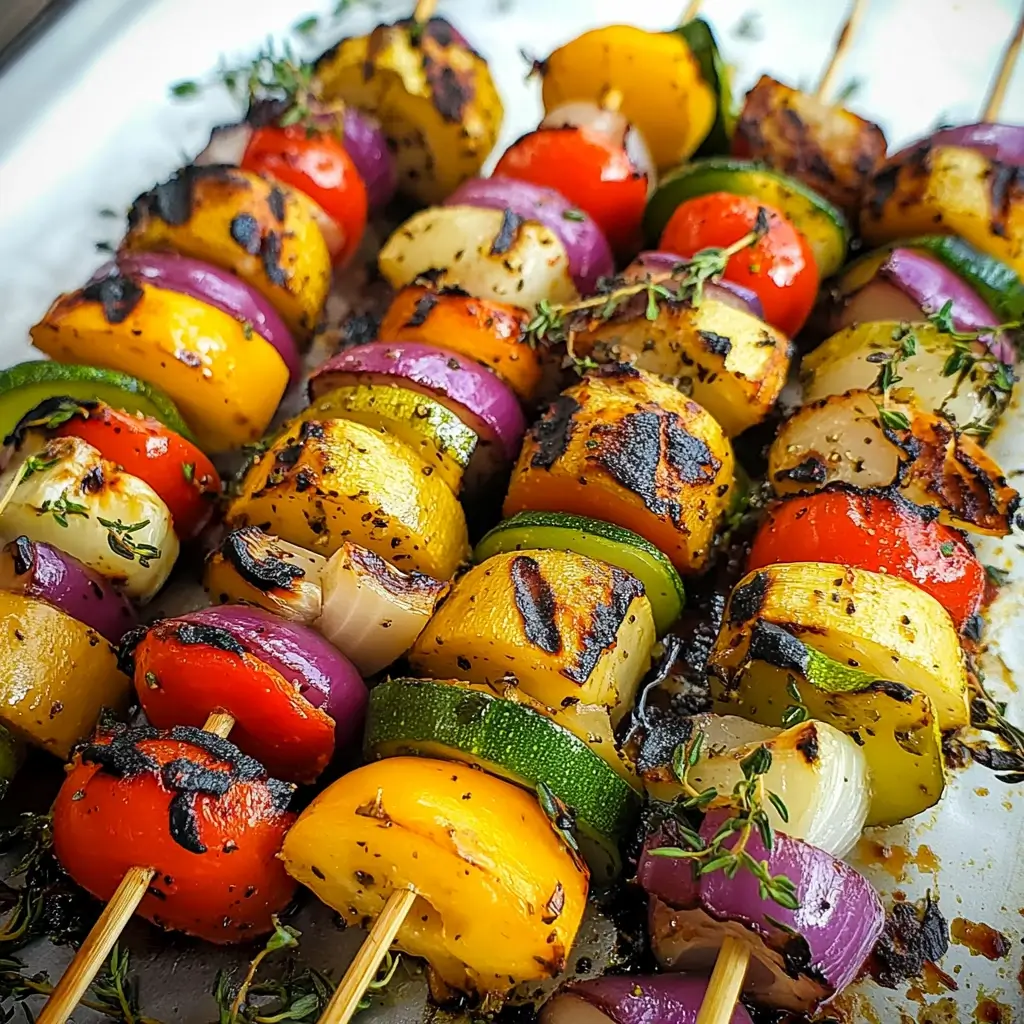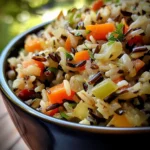Our family gatherings, especially during the warmer months, are almost incomplete without a platter of these colorful skewers. The first time I made these, I was genuinely surprised by how quickly they disappeared. My kids, who can sometimes be a bit picky with their veggies, were suddenly enchanted by vegetables-on-a-stick. The slight char from the grill, combined with the tangy, herbaceous marinade, transformed simple produce into a culinary delight. My husband, a self-proclaimed carnivore, even admitted he could happily make a meal out of just these kabobs (though he usually pairs them with grilled chicken!). They’ve become a staple not just for their taste, but for their incredible versatility and the sheer joy they bring to the table with their rainbow hues. It’s a recipe that’s both impressively elegant for guests and wonderfully simple for a weeknight.
The Ultimate Grilled Vegetable Kabobs: A Symphony of Summer Flavors
Vegetable kabobs, also known as veggie skewers, are the quintessential dish for summer barbecues, healthy weeknight dinners, or any occasion where you want to add a vibrant, flavorful, and nutritious element to your meal. They are incredibly customizable, allowing you to use your favorite seasonal vegetables, and they cook relatively quickly, making them a convenient option. The magic lies in the combination of fresh, crisp-tender vegetables, a delicious marinade that infuses them with flavor, and that irresistible smoky char from the grill.
Why These Vegetable Kabobs Will Become Your Go-To Grilling Recipe
Before we dive into the nitty-gritty, let’s talk about why this particular vegetable kabob recipe is a cut above the rest:
- Flavor Explosion: The marinade is key! We’re using a balanced blend of olive oil, zesty lemon, aromatic garlic, and a medley of herbs that perfectly complement the natural sweetness of the vegetables.
- Visually Stunning: A rainbow of colors on a skewer isn’t just healthy; it’s incredibly appetizing. They are a feast for the eyes before they even hit your plate.
- Highly Customizable: Don’t like mushrooms? Swap them out! Love pineapple? Add it in! This recipe is a fantastic base for your culinary creativity.
- Healthy & Nutritious: Packed with vitamins, minerals, and fiber, vegetable kabobs are a guilt-free indulgence.
- Grill, Oven, or Broiler Friendly: While grilling provides that signature smoky flavor, we’ll also cover how to make these beauties in your oven or under the broiler.
- Perfect for All Eaters: Naturally vegetarian and vegan (ensure your marinade ingredients are vegan-friendly), and easily made gluten-free.
Ingredients for Perfect Vegetable Kabobs
This recipe aims for a balance of color, texture, and flavor. Feel free to adjust based on availability and preference. This quantity serves approximately 4-6 people as a side dish.
- For the Kabobs:
- 1 large red bell pepper, cored, seeded, and cut into 1.5-inch chunks
- 1 large yellow or orange bell pepper, cored, seeded, and cut into 1.5-inch chunks
- 1 large green bell pepper, cored, seeded, and cut into 1.5-inch chunks
- 1 large red onion, peeled and cut into 1.5-inch chunks (try to keep layers together)
- 1 large zucchini, trimmed and cut into 1-inch thick rounds or half-moons
- 1 large yellow summer squash, trimmed and cut into 1-inch thick rounds or half-moons
- 8 ounces cremini or button mushrooms, stems trimmed, larger ones halved
- 1 pint cherry or grape tomatoes
- Optional: 1 small pineapple, cored and cut into 1.5-inch chunks (for a sweet and savory twist)
- Optional: Pre-cooked corn on the cob, cut into 1-inch rounds
- For the Marinade:
- 1/2 cup extra virgin olive oil
- 1/4 cup freshly squeezed lemon juice (about 1-2 lemons)
- 2 tablespoons balsamic vinegar (optional, for a deeper flavor)
- 3-4 cloves garlic, minced
- 1 tablespoon dried Italian seasoning (or a mix of dried oregano, basil, thyme)
- 1 teaspoon dried rosemary, crushed
- 1 teaspoon Dijon mustard (helps emulsify the marinade)
- 1 teaspoon sea salt, or to taste
- 1/2 teaspoon black pepper, freshly ground, or to taste
- Optional: 1/4 teaspoon red pepper flakes for a hint of spice
- Equipment:
- 8-12 skewers (if using wooden skewers, soak them in water for at least 30 minutes to prevent burning)
- Large mixing bowl or a large resealable plastic bag
Crafting the Perfect Marinade: The Secret to Flavorful Kabobs
The marinade is what elevates your vegetables from simple to sublime. Our chosen blend is bright, herbaceous, and savory.
- Whisk Together: In a small bowl, whisk together the extra virgin olive oil, lemon juice, balsamic vinegar (if using), minced garlic, Italian seasoning, dried rosemary, Dijon mustard, sea salt, black pepper, and red pepper flakes (if using).
- Taste and Adjust: Give the marinade a taste. Does it need more salt? A bit more lemon for brightness? Adjust seasonings as necessary. Remember that the flavors will mellow slightly once on the vegetables.
This marinade is fantastic, but feel free to experiment! Other great marinade bases include:
- Asian-inspired: Soy sauce, sesame oil, rice vinegar, ginger, garlic, honey/maple syrup.
- Spicy & Smoky: Olive oil, lime juice, chipotle powder, smoked paprika, cumin, garlic powder, onion powder.
- Herby Yogurt: Plain yogurt, lemon juice, dill, mint, garlic, olive oil (great for a Mediterranean twist).
Step-by-Step Instructions for Grilling Vegetable Kabobs
Follow these simple steps for perfectly grilled vegetable kabobs every time.
- Prepare the Vegetables: Wash and chop all your vegetables into roughly uniform sizes (around 1 to 1.5 inches). This ensures even cooking. If your mushrooms are large, halve or quarter them. Keep cherry tomatoes whole.
- Marinate the Vegetables: Place all the chopped vegetables in a large mixing bowl or a large resealable plastic bag. Pour the prepared marinade over the vegetables. Gently toss or seal the bag and turn to coat everything evenly. Let the vegetables marinate at room temperature for at least 30 minutes, or for more intense flavor, cover and refrigerate for 1-4 hours. If refrigerating, bring them to room temperature for about 20-30 minutes before grilling.
- Soak Skewers (if using wood): If you’re using wooden or bamboo skewers, make sure they have been soaking in water for at least 30 minutes. This prevents them from catching fire on the grill. Metal skewers do not require soaking.
- Assemble the Kabobs: Thread the marinated vegetables onto the skewers, alternating colors and types for a visually appealing and balanced kabob. Try to pack them snugly but not too tightly, allowing heat to circulate. Leave a little space at each end of the skewer for easier handling.
- Pro-tip for onions: Try to keep 2-3 layers of the red onion chunks together when skewering; they hold up better and offer a more substantial bite.
- Pro-tip for tomatoes: Cherry tomatoes can sometimes split. Skewer them carefully.
- Preheat the Grill: Preheat your outdoor grill to medium-high heat (around 375-450°F or 190-230°C). Clean the grill grates well and then lightly oil them using a paper towel dipped in high-heat oil (like canola or avocado oil) held with tongs. This prevents sticking.
- Grill the Kabobs: Place the assembled kabobs directly on the preheated, oiled grill grates.
- Cook for approximately 10-15 minutes in total, turning them every 3-4 minutes, until the vegetables are tender-crisp and have nice char marks.
- Cooking time will vary depending on the heat of your grill and the size of your vegetable chunks. Softer vegetables like zucchini and bell peppers will cook faster than denser ones if they were cut larger.
- If you have any leftover marinade, you can brush it onto the kabobs during the first half of grilling. Discard any marinade that has come into contact with raw vegetables after that point to avoid cross-contamination.
- Rest and Serve: Once cooked to your liking, carefully remove the kabobs from the grill. Let them rest for a few minutes before serving. This allows the juices to redistribute.
Alternative Cooking Methods: Oven-Roasted or Broiled Kabobs
No grill? No problem! These kabobs are also delicious when cooked in the oven.
Oven-Roasted Method:
- Preheat your oven to 400°F (200°C).
- Assemble the kabobs as instructed above.
- Place the kabobs on a baking sheet lined with parchment paper or a lightly oiled baking rack set inside a baking sheet (a rack allows for better air circulation).
- Roast for 15-25 minutes, flipping them halfway through, until the vegetables are tender and slightly caramelized. Keep an eye on them as oven temperatures can vary.
Broiler Method:
- Position an oven rack about 4-6 inches from the broiler element. Preheat the broiler to high.
- Assemble the kabobs and place them on a broiler pan or a baking sheet lined with foil.
- Broil for 3-5 minutes per side, watching very carefully as they can burn quickly under the broiler. You’re looking for charring and tenderness. Turn them 2-3 times during cooking.
Estimated Nutrition Facts
- Servings: Approximately 4-6 (as a side dish, makes about 8-10 skewers)
- Calories per serving (estimated for 1/6th of recipe, about 2 skewers): Approximately 180-250 calories.
Disclaimer: Nutritional information is an estimate and can vary significantly based on the exact ingredients, quantities used, and any variations. The primary calorie sources are olive oil and the natural sugars in vegetables.
Preparation and Cooking Time
- Preparation Time: 25-35 minutes (includes chopping vegetables and making marinade)
- Marinating Time: 30 minutes (minimum) to 4 hours (for best flavor)
- Cooking Time (Grill): 10-15 minutes
- Cooking Time (Oven): 15-25 minutes
- Total Time (excluding extended marinating): Approximately 1 hour to 1 hour 15 minutes
How to Serve Your Delicious Vegetable Kabobs
Vegetable kabobs are incredibly versatile. Here are some serving suggestions:
- As a Side Dish:
- Pair with grilled meats like chicken, steak, fish, or shrimp.
- Serve alongside burgers or hot dogs at a BBQ.
- Accompany with other vegetarian mains like grilled halloumi, tofu steaks, or veggie burgers.
- As a Main Course (for a lighter meal):
- Serve over a bed of quinoa, couscous, farro, or brown rice.
- Pair with a hearty salad, like a Greek salad or a pasta salad.
- Offer with warm pita bread and a side of hummus or tzatziki sauce for dipping.
- With Dips and Sauces:
- Tzatziki: A cool, creamy cucumber and yogurt dip.
- Hummus: Classic chickpea dip adds protein and creaminess.
- Pesto: Basil pesto adds a fresh, herbaceous kick.
- Balsamic Glaze: A drizzle of sweet and tangy balsamic glaze enhances the roasted flavors.
- Garlic Aioli: A rich and flavorful garlic mayonnaise.
- Chimichurri: A vibrant Argentinian sauce made with parsley, garlic, vinegar, and oil.
- Presentation:
- Arrange artfully on a large platter.
- Garnish with fresh herbs like chopped parsley, cilantro, or basil just before serving.
- A squeeze of fresh lemon juice over the finished kabobs can brighten the flavors.
Mastering the Grill: Additional Tips for Kabob Success
- Uniform Cuts are Key: Chopping your vegetables into similar-sized pieces (around 1 to 1.5 inches) is crucial. This ensures that everything cooks evenly. If some pieces are too small, they’ll burn before larger pieces are tender.
- Don’t Overcrowd the Skewers: While you want them snug, avoid packing the vegetables too tightly. A little space between pieces allows the heat to circulate properly, ensuring even cooking and better charring. If they’re too cramped, they’ll steam rather than grill.
- Double Skewer Softer Items: For softer items like cherry tomatoes or small mushroom caps that might spin or fall off, consider using two parallel skewers. This provides more stability and makes them easier to turn.
- Consider Par-Cooking Denser Vegetables: If you’re including very dense vegetables like potato chunks or whole small new potatoes, you might want to par-boil or microwave them briefly (until just slightly tender) before marinating and skewering. This ensures they cook through on the grill without the other vegetables overcooking.
- Use a Grill Basket for Small Veggies: If you have small vegetable pieces that are difficult to skewer or prone to falling through the grates (like sliced mushrooms or small broccoli florets), a grill basket is an excellent alternative. Marinate them as usual and then grill them in the basket alongside your kabobs.
Frequently Asked Questions (FAQ) About Vegetable Kabobs
Q1: What are the best vegetables to use for kabobs?
A: The best vegetables are those that hold their shape well during grilling and offer a good combination of flavor and texture. Favorites include bell peppers (all colors), red onions, zucchini, yellow squash, cherry/grape tomatoes, mushrooms (cremini, button, portobello chunks), and even broccoli or cauliflower florets (can be blanched first). Pineapple chunks add a great sweet element. Avoid vegetables that cook too quickly and fall apart, like leafy greens, unless added at the very end or protected.
Q2: How do I prevent my vegetables from sticking to the grill?
A: There are a few key steps:
* Clean Grill: Start with clean grill grates. Food debris causes sticking.
* Oil the Grates: After preheating, lightly oil the grates. Use a paper towel soaked in high-heat oil (like canola or avocado) and rub it over the grates with tongs.
* Oil the Veggies: Ensure your vegetables are well-coated in the olive oil-based marinade. The oil acts as a barrier.
* Hot Enough Grill: Make sure your grill is properly preheated to medium-high. If it’s not hot enough, food is more likely to stick.
* Don’t Flip Too Soon: Allow the vegetables to develop a good sear and char marks before attempting to flip them. They will release more easily once properly seared.
Q3: Can I make vegetable kabobs ahead of time?
A: Yes, you can do much of the prep work in advance!
* Chop Vegetables: You can chop the vegetables a day or two ahead and store them in an airtight container in the refrigerator.
* Make Marinade: The marinade can be made up to 3-4 days in advance and stored in an airtight container in the refrigerator.
* Marinate: You can marinate the vegetables for up to 4 hours in the refrigerator. Some suggest not marinating tomatoes for too long as they can become mushy. You can always add them to the marinade in the last hour.
* Assemble: You can assemble the kabobs a few hours before grilling and keep them covered in the fridge. Allow them to come to room temperature for about 20-30 minutes before grilling for more even cooking.
Q4: How long should I marinate the vegetables for kabobs?
A: A minimum of 30 minutes at room temperature is good for a quick flavor infusion. For deeper flavor, marinate for 1 to 4 hours in the refrigerator. Be cautious with marinating for too long (e.g., overnight), especially with more acidic marinades, as some vegetables (like zucchini or mushrooms) can become overly soft or break down. Tomatoes, in particular, are best marinated for a shorter period.
Q5: Are vegetable kabobs healthy?
A: Absolutely! Vegetable kabobs are packed with vitamins, minerals, antioxidants, and fiber from the diverse array of vegetables. The marinade, typically olive oil-based, provides healthy monounsaturated fats. They are naturally low in calories and can be a fantastic way to increase your vegetable intake. To keep them at their healthiest, be mindful of the amount of oil and salt in your marinade and choose lean proteins if serving them as part of a larger meal. Grilling is also a healthier cooking method compared to frying.
Enjoy these vibrant, flavorful, and healthy vegetable kabobs at your next cookout or family dinner! They are a true celebration of fresh produce and a guaranteed crowd-pleaser.
Print
Grilled Vegetable Kabobs Recipe
Ingredients
- For the Kabobs:
- 1 large red bell pepper, cored, seeded, and cut into 1.5-inch chunks
- 1 large yellow or orange bell pepper, cored, seeded, and cut into 1.5-inch chunks
- 1 large green bell pepper, cored, seeded, and cut into 1.5-inch chunks
- 1 large red onion, peeled and cut into 1.5-inch chunks (try to keep layers together)
- 1 large zucchini, trimmed and cut into 1-inch thick rounds or half-moons
- 1 large yellow summer squash, trimmed and cut into 1-inch thick rounds or half-moons
- 8 ounces cremini or button mushrooms, stems trimmed, larger ones halved
- 1 pint cherry or grape tomatoes
- Optional: 1 small pineapple, cored and cut into 1.5-inch chunks (for a sweet and savory twist)
- Optional: Pre-cooked corn on the cob, cut into 1-inch rounds
- For the Marinade:
- 1/2 cup extra virgin olive oil
- 1/4 cup freshly squeezed lemon juice (about 1–2 lemons)
- 2 tablespoons balsamic vinegar (optional, for a deeper flavor)
- 3–4 cloves garlic, minced
- 1 tablespoon dried Italian seasoning (or a mix of dried oregano, basil, thyme)
- 1 teaspoon dried rosemary, crushed
- 1 teaspoon Dijon mustard (helps emulsify the marinade)
- 1 teaspoon sea salt, or to taste
- 1/2 teaspoon black pepper, freshly ground, or to taste
- Optional: 1/4 teaspoon red pepper flakes for a hint of spice
Instructions
- Prepare the Vegetables: Wash and chop all your vegetables into roughly uniform sizes (around 1 to 1.5 inches). This ensures even cooking. If your mushrooms are large, halve or quarter them. Keep cherry tomatoes whole.
- Marinate the Vegetables: Place all the chopped vegetables in a large mixing bowl or a large resealable plastic bag. Pour the prepared marinade over the vegetables. Gently toss or seal the bag and turn to coat everything evenly. Let the vegetables marinate at room temperature for at least 30 minutes, or for more intense flavor, cover and refrigerate for 1-4 hours. If refrigerating, bring them to room temperature for about 20-30 minutes before grilling.
- Soak Skewers (if using wood): If you’re using wooden or bamboo skewers, make sure they have been soaking in water for at least 30 minutes. This prevents them from catching fire on the grill. Metal skewers do not require soaking.
- Assemble the Kabobs: Thread the marinated vegetables onto the skewers, alternating colors and types for a visually appealing and balanced kabob. Try to pack them snugly but not too tightly, allowing heat to circulate. Leave a little space at each end of the skewer for easier handling.
- Pro-tip for onions: Try to keep 2-3 layers of the red onion chunks together when skewering; they hold up better and offer a more substantial bite.
- Pro-tip for tomatoes: Cherry tomatoes can sometimes split. Skewer them carefully.
- Preheat the Grill: Preheat your outdoor grill to medium-high heat (around 375-450°F or 190-230°C). Clean the grill grates well and then lightly oil them using a paper towel dipped in high-heat oil (like canola or avocado oil) held with tongs. This prevents sticking.
- Grill the Kabobs: Place the assembled kabobs directly on the preheated, oiled grill grates.
- Cook for approximately 10-15 minutes in total, turning them every 3-4 minutes, until the vegetables are tender-crisp and have nice char marks.
- Cooking time will vary depending on the heat of your grill and the size of your vegetable chunks. Softer vegetables like zucchini and bell peppers will cook faster than denser ones if they were cut larger.
- If you have any leftover marinade, you can brush it onto the kabobs during the first half of grilling. Discard any marinade that has come into contact with raw vegetables after that point to avoid cross-contamination.
- Rest and Serve: Once cooked to your liking, carefully remove the kabobs from the grill. Let them rest for a few minutes before serving. This allows the juices to redistribute.
Nutrition
- Serving Size: One Normal Portion
- Calories: 180-250





